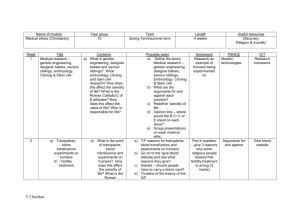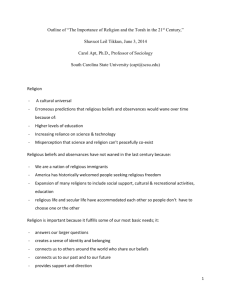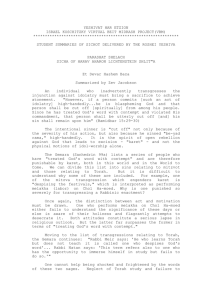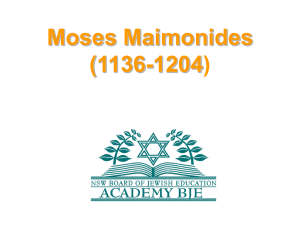The Sanctity of God`s Name, Part 1
advertisement
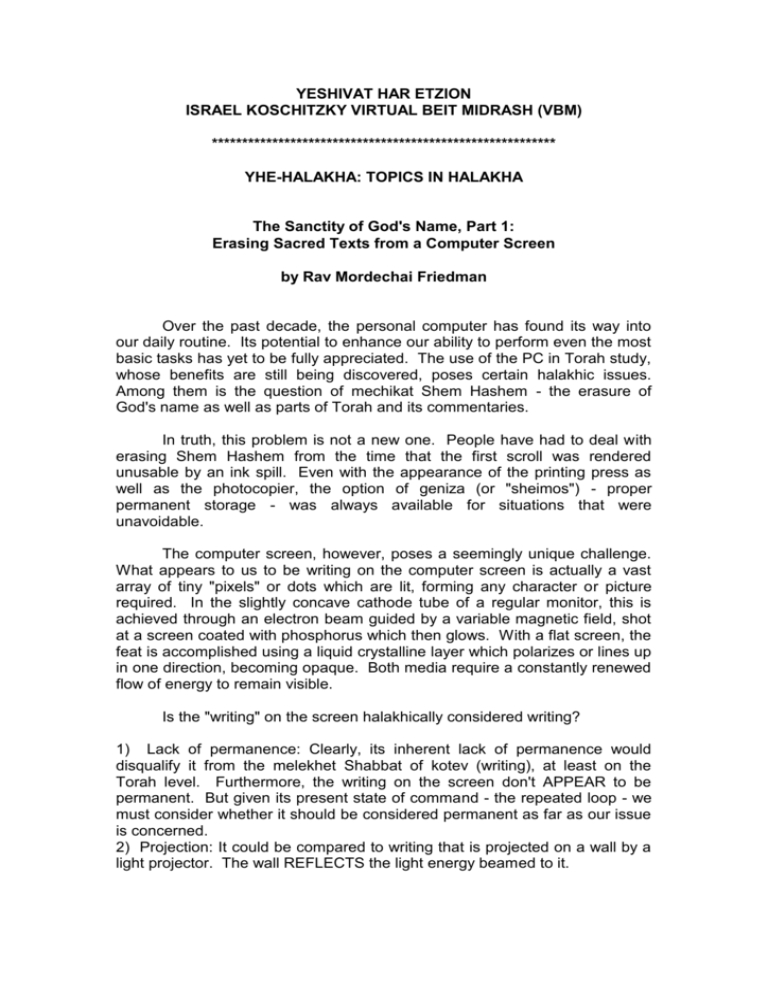
YESHIVAT HAR ETZION ISRAEL KOSCHITZKY VIRTUAL BEIT MIDRASH (VBM) ********************************************************* YHE-HALAKHA: TOPICS IN HALAKHA The Sanctity of God's Name, Part 1: Erasing Sacred Texts from a Computer Screen by Rav Mordechai Friedman Over the past decade, the personal computer has found its way into our daily routine. Its potential to enhance our ability to perform even the most basic tasks has yet to be fully appreciated. The use of the PC in Torah study, whose benefits are still being discovered, poses certain halakhic issues. Among them is the question of mechikat Shem Hashem - the erasure of God's name as well as parts of Torah and its commentaries. In truth, this problem is not a new one. People have had to deal with erasing Shem Hashem from the time that the first scroll was rendered unusable by an ink spill. Even with the appearance of the printing press as well as the photocopier, the option of geniza (or "sheimos") - proper permanent storage - was always available for situations that were unavoidable. The computer screen, however, poses a seemingly unique challenge. What appears to us to be writing on the computer screen is actually a vast array of tiny "pixels" or dots which are lit, forming any character or picture required. In the slightly concave cathode tube of a regular monitor, this is achieved through an electron beam guided by a variable magnetic field, shot at a screen coated with phosphorus which then glows. With a flat screen, the feat is accomplished using a liquid crystalline layer which polarizes or lines up in one direction, becoming opaque. Both media require a constantly renewed flow of energy to remain visible. Is the "writing" on the screen halakhically considered writing? 1) Lack of permanence: Clearly, its inherent lack of permanence would disqualify it from the melekhet Shabbat of kotev (writing), at least on the Torah level. Furthermore, the writing on the screen don't APPEAR to be permanent. But given its present state of command - the repeated loop - we must consider whether it should be considered permanent as far as our issue is concerned. 2) Projection: It could be compared to writing that is projected on a wall by a light projector. The wall REFLECTS the light energy beamed to it. If someone would turn off a projected Name of God - it would be difficult to consider him liable, because a) the wall is not physically altered, and b) the characters are not PERCEIVED as newly created objects. However, we can differentiate between the wall and the pixels. The reflecting wall is really physically unchanged. The pixels are. The glowing phosphor reacts with the energy beamed to it by sending out energy in a new form of light. The crystal-liquid display is being re-arranged - creating a physical representation of character-writing. Secondly, why assume that the issur of erasure of God's name requires normal halakhic writing? Isn't it just as degrading to erase a name which APPEARS to be the written name of God? If it is prohibited to erase God's name as well as Torah commentaries, from the screen we can not entertain the idea of retaining the name in its position for eternity. I say "in its position" because even a one-line scroll, when the text on the screen appears to shift position, is actually erasing the text from one area and re-writing it in another. Theoretically, we are therefore faced with two practical possibilities - either it is halakhically permissible to scroll, or we must exclude computer use from all areas of Torah study. As God-fearing Jews, we can never dismiss, with a wave of our hand, such an astoundingly prohibitive situation and proclaim, "This couldn't be what the Torah 'wants!'" In areas of issur ve-heter, our window into the Will of God is found within the "dalet amot shel Halakha." We therefore need to explore the nature of the issur. The Nature of "Lo Ta'asun Ken" The Torah states (Devarim 12:2-3): "You shall utterly destroy all the places in which the nations whom you are to dispossess served their gods... and you shall overthrow their altars, and break their pillars... and destroy their name out of that place." This is followed by "lo ta'asun ken la-Hashem Elokeikhem" - "you shall not do so to the Lord your God." The Sifri explains that we are thus enjoined not to rub out the name of God, nor to break off any stones from the altar or the azara (Temple courtyard). Based on the wording of the verse, we can now organize our investigation: a. "La-Hashem Elokeikhem" - the written name of God: what is the object which it is the prohibition to destroy? b. "Lo ta'asun ken" - how do we define the destructive act? a) The Halakhic Definition of the Object The Rambam defines the prohibition in his Sefer Ha-mitzvot (lo ta'aseh 65): "One must not destroy [any part of] the Temple or synagogues or study halls. Likewise, one must not erase the holy names. And one must not destroy the holy writings. As it is written, 'You shall surely destroy ...'" While the midrash halakha (Sifri ibid.) mentions only the holy names, the Rambam expands the list to include the Beit Ha-mikdash, synagogues, study halls, as well as all of Torah, Nevi'im and Ketuvim. His source seems to be the parallel in the pesukim between the various objects of idolatry that must be destroyed and the concluding phrase of "You shall not do so to Hashem." It would appear that this is the ruling of the Rema (OC 152:1), who quotes the Mordekhai. The Maharik (#61) explains: "For the beit ha-midrash is called a lesser Beit Ha-mikdash (mikdash me'at) and therefore it is prohibited to break any object of the beit hamidrash, as it is taught in the Sifri: 'From where do we know that breaking a stone of the Temple or the altar or the courtyard is a negative commandment, etc.'" [The Bi'ur ha-Gra on the Rema quotes this Sifri as his source.] Later commentaries (such as the Peri Megadim, ibid., and Rav Yitzchak Elchanan Spector in Ein Yitzchak, #5) question the possibility that the Rambam in Sefer Ha-mitzvot rules that destruction of a part of a beit midrash or beit knesset would be de-oraita - a Torah-based prohibition. Is the sanctity of our modern-day structures on the same level as the Beit Hamikdash? [Laws of hekdesh and me'ila - sanctification and misuse of sacred objects - clearly apply only to the Beit Ha-mikdash and not to a shul or beit midrash!] In fact, the Ran states explicitly that the sanctity of a shul is derabbanan (of rabbinic origin). Thus, many Acharonim conclude that the Sefer Ha-mitzvot must be explained contrary to its simple reading and we are forced to conclude that the prohibition of destroying parts of a shul or beit midrash is only mi-derabbanan. It appears to me that the Rambam's Sefer Ha-mitzvot can be explained as is. And with this explanation, we will be touching on one of the main facets of the issue at hand. The nature of the prohibition can be understood in two ways: 1. It is possible that the prohibition applies only to objects which have physical sanctity, such as the structure of the Temple or God's written name. All of these carry a halakhic status of physical sanctity. This would seem to be the understanding of Rav Yitzchak Elchanan and others. (It is further possible to explain the Rema and his sources to have felt that there IS some physical sanctity mi-deoraita to a shul or beit midrash without the higher level of sanctity of the Temple.) 2. It is possible, however, to understand the nature of the prohibition in a completely different light. We are not concerned merely with the resultant destruction caused by one's actions; rather, one is forbidden to display contempt or disrespect towards symbols of holiness. In this case, we must include in the prohibition all objects which symbolize God - not only the technically sanctified but the purely symbolic as well. Thus, the destruction of a shul or beit midrash would be an issur de-oraita as the Rambam stated in the Sefer Ha-mitzvot. Interestingly enough, the Rambam seems to be taking the first direction in his Mishneh Torah (Hilkhot Yesodei ha-Torah 6:8): "It is forbidden to burn or destroy the Holy Scriptures - including their explanations and commentaries... When does this apply? Only to Scriptures written by a Jew in sanctity. However, a sefer Torah written by an apikoros (heretic) must be burnt, including the names of God which appear therein, since he does not believe in the sanctity of the Name and [therefore] did not write it with the proper intention [lishmah]; rather, he thinks that it is mundane, and since his belief is such, the name is not sanctified." The name of God when written by an apikoros has the appearance of any name and is therefore no less symbolic. Yet, since it has no sanctity, it may be destroyed. This indicates that the Rambam changed his original view in the Sefer Ha-mitzvot of the issur being a symbolic act of degradation, to that of an issur cheftza, a prohibition pivoting around a physical object with a specific halakhic status. An additional indication of this change can be noted by the fact that the halakha of beit ha-knesset or beit ha-midrash mentioned in the Sefer Hamitzvot is nowhere to be found in the Mishneh Torah. Even according to those who would explain that the Sefer Ha-mitzvot refers to an issur derabanan, the Rambam should have cited it in the Mishneh Torah! According to the understanding of issur cheftza, the Mishneh Torah is clear - only physical objects which are technically sanctified carry a prohibition of destruction. These two basic possibilities have equal validity when we look at the pesukim themselves. The mitzva to eradicate objects of idolatry when entering Israel is result-oriented, in that the focus is on the end destruction. However, "Lo ta'asun ken la-Hashem Elokeikhem" can mean either: a) the required eradication of the objects of idolatry should never be performed on objects of sanctity; or b) the mitzva to destroy idolatry entails degrading it and one should not similarly degrade God. Thus far, we have seen two cases which hinge on our understanding of the nature of the issur: 1) The destruction of a beit ha-midrash - can be prohibited mi-deoraita; - prohibited mi-derabanan; - or carry no specific prohibition of "lo ta'asun;" 2) God's name written accurately but lacking inherent sanctity (e.g. if written with inappropriate attention to its meaning or without intention to sanctify) - is forbidden to erase if the issur is not to degradate God's name (because this is an accurate symbolic representation); - or can be erased since it lacks inherent sanctity. This halakha is of central importance to our main question. If a name, appearing on the screen, has no inherent sanctity, erasure for non-destructive purpose would be permissible. How do the poskim rule? The Shakh (YD 276:12) rules that if God's name is written with inappropriate attention to its meaning or without intention to sanctify, it can be erased and rewritten. The Peri Chadash (as quoted by the Machaneh Efraim, YD, Hilkhot Sefer Torah) disagrees with the Shakh and feels that any name is prohibited to erase. It would seem that they argue exactly about the issue we raised above. Following the same pesak of the Shakh are Rav Shlomo Kluger (Shenot Chayim, Hilkhot Stam, #5), the Noda Bi-yehuda (first edition, YD #150) and Yabi'a Omer. The Peri Chadash seems to be a minority opinion. The Shach was not only referring to a Name written without any intention of writing those letters. He clearly refers to lack of "lishma" or intention to sanctify. In other words, shem Hashem can be purposefully written and yet lack lishma and thus lack sanctity. Add to this lack of positive lisma a purpose or situation which lends itself to negative intent of sanctity. A medium which is regularly erased or disposed of would automatically define the Name to lack sanctity. Along these lines, since the time of the printing press many poskim have dealt with the question of galleys, pages printed solely for the purpose of proof-reading. Some allowed the disposal through burning, on the basis that there was no intent to sanctifying these sheets (see the Netziv, Meishiv Da'at, 2:80). Others added the additional requirement, if possible, of having negative intent - specifically intending not to impart sanctity at the time of printing (Rav Yitzchak Elchanan Spector, Ein Yitzchak, OC 5). Still others allowed the above if no name of God appears. Computer Screens One responsum which is strikingly relevant to computer screens is that of Rav Yitzchak Elchanan Spector (Rav of Kovno from 1896 to 1917) dealing with the issue of galleys. He quotes the gemara in Megilla (32a): "Rav Matna said: The 'luchot' and the podium do not have any sanctity." Some Rishonim translate "luchot" to be the blank margins of a sefer Torah. However, the Rambam (Hilkhot Sefer Torah 10:4) and the Mordekhai translate it to mean chalk boards used to teach children. Rav Spector proves from this that if there is no positive intent for PERMANENT writing - then this renders the writing devoid of sanctity. How much more so with a computer screen - with any use, it will "scroll" and "erase" the writing from its original position! There are poskim (Tashbetz, responsum 2), however, who felt that the writing on chalk boards, although not permanent, had sanctity. Many other halakhot depend on our question of the nature of the issur of "lo ta'asun ken." Here are some that are relevant to our halakhic query: 1a) Does the written name need to be the style of Ashurit, the type required for a sefer Torah, in order to proscribe erasure? (See Orchot Chaim, YD, page 29.) 1b) Chak tokhot - a holy name formed by removing ink from a surface so that the remaining ink forms letters: does such writing prohibit erasure? (The Beit Shelomo [YD 2:134] claims that the majority of poskim allow erasure in this case.) 2) When Hashem's name is translated into another language, such as "God" - can it be erased? This, too, would depend on our dilemma. The majority of poskim feel it can be erased (Shakh YD 179:11; Kesef Ha-sofer, chapt. 11, in Lishkat ha-sefer s.k. 5; Yabia Omer, YD 4:20). This last point is helpful for all non-Hebrew languages and extends to the issue of computer generated print-outs, rendering them devoid of the sanctity of God's name. But do they have another form of sanctity? The Sanctity of the Written Torah on Printed Media This brings us to the last halakha which may hinge on our question of the nature of the issur. If the issur is not to degrade anything which symbolizes God, it would include shuls, names written without proper intent, names written not in accordance with the various laws of Torah writing, as well as the word "God." Now that it appears that the accepted pesak follows the other understanding (namely, that the issur applies only to destroying objects with a status of sanctity), would it then follow that pesukim or written Torah insights are devoid of any such sanctity? Granted, deletion from a computer screen is permissible but would outright destruction of printed material be permissible? With the help of God, I hope to deal with this issue in the future. Reprinted in Alei Etzion vol. 8. FOLLOW-UP TO THIS SHIUR To all subscribers to our Halakha series: The following are two questions from our readers that I find to be very relevant. 1) Reb Mordechai: Yasher Koach on your mailing on erasing shem Hashem from a computer screen. I have a question/comment. What would be your reaction to shutting off a slide projector that was projecting a text with shem Hashem onto a screen? By doing so, you are erasing the shem from the screen. My gut reaction would be that there was never anything written on the screen so there was nothing erased. I believe a CRT is the same thing. There is nothing written there. It is a continuously (30 times/sec.) refreshed projector. Just a thought. Comments? 2) Today's shiur was very interesting and informative, le-halakha. However, I believe that le-ma'aseh there is no possible way for this question to actually arise in practice. With all due respect, I believe the entire she'eila is based on an error. My understanding is that the image on a computer screen is refreshed about 50 or 60 times per second, and that it fades automatically if that refresh does not occur. Therefore, it is not POSSIBLE to ever erase something from a computer screen. The worst one might do is prevent something from being refreshed on the screen. You gave the example that "when the text on the screen appears to shift position, is actually erasing the text from one area and re-writing it in another." But I think you are wrong. One CANNOT "erase the text from one area" of the computer screen. Rather, one tells the system not to refresh that part of the screen, which is a different matter entirely. If one would invoke the principle of "grama" and ask if it is permissible to erase the Name by preventing the refresh, then one might have a good question, but that is not the approach you have taken. But if I am correct, then it is not prohibited to erase a computer screen, because it is not *possible* to erase a computer screen. Here is my reply: I fully agree with the above-mentioned points. The article SHOULD have contained the following introduction in order to establish its practical halakhic relevance: What appears to us to be writing on the computer screen is actually a vast array of tiny "pixels" or dots which are lit, forming any character or picture required. In the slightly concave cathode tube of a regular monitor, this is achieved through an electron beam guided by a variable magnetic field, shot at a screen coated with phosphorus which then glow. With a flat screen, the feat is accomplished using a liquid crystalline layer which polarizes or lines up in one direction, becoming opaque. Both media require a constantly renewed flow of energy to remain visible. Is the "writing" on the screen halakhically considered writing? 1) Lack of permanence: Clearly, its inherent lack of permanence would disqualify it from the melekhet Shabbat of kotev (writing), at least on the Torah level. Furthermore, the writing on the screen don't APPEAR to be permanent. But given its present state of command - the repeated loop - we must consider whether it should be considered permanent as far as our issue is concerned. 2) Projection: It could be compared to writing that is projected on a wall by a light projector. The wall REFLECTS the light energy beamed to it. If someone would turn off a projected Name of God - it would be difficult to consider him liable, because a) the wall is not physically altered, and b) the characters are not PERCEIVED as newly created objects. However, we can differentiate between the wall and the pixels. The reflecting wall is really physically unchanged. The pixels are. The glowing phosphor reacts with the energy beamed to it by sending out energy in a new form of light. The crystal-liquid display is being rearranged - creating a physical representation of character-writing. Secondly, why assume that the issur of erasure of God's name requires normal halakhic writing? Isn't it just as degrading to erase a name which APPEARS to be the written name of God? We therefore need to explore the nature of the issur (as we then proceeded to do in the article!). Rav Mordechai Friedman P.S. I welcome any further comments!

